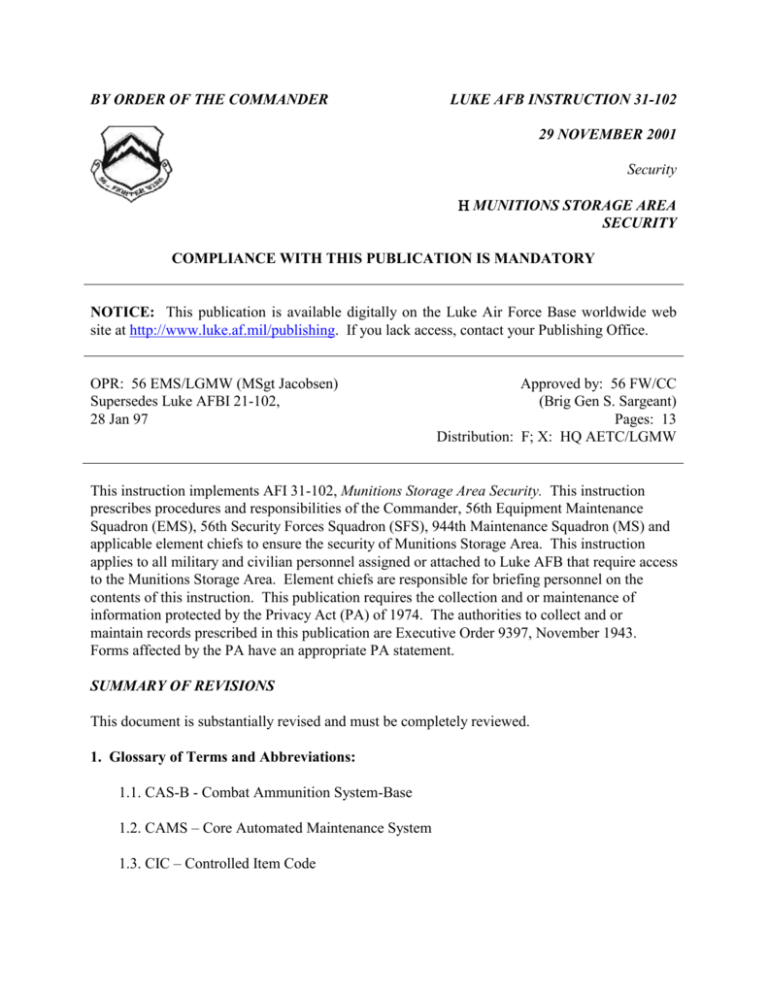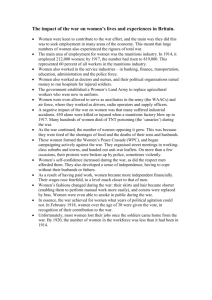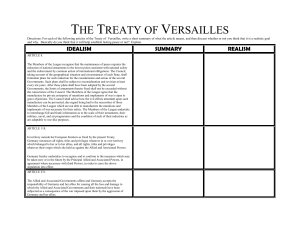Munitions Storage Area Security
advertisement

BY ORDER OF THE COMMANDER LUKE AFB INSTRUCTION 31-102 29 NOVEMBER 2001 Security MUNITIONS STORAGE AREA SECURITY COMPLIANCE WITH THIS PUBLICATION IS MANDATORY NOTICE: This publication is available digitally on the Luke Air Force Base worldwide web site at http://www.luke.af.mil/publishing. If you lack access, contact your Publishing Office. OPR: 56 EMS/LGMW (MSgt Jacobsen) Supersedes Luke AFBI 21-102, 28 Jan 97 Approved by: 56 FW/CC (Brig Gen S. Sargeant) Pages: 13 Distribution: F; X: HQ AETC/LGMW This instruction implements AFI 31-102, Munitions Storage Area Security. This instruction prescribes procedures and responsibilities of the Commander, 56th Equipment Maintenance Squadron (EMS), 56th Security Forces Squadron (SFS), 944th Maintenance Squadron (MS) and applicable element chiefs to ensure the security of Munitions Storage Area. This instruction applies to all military and civilian personnel assigned or attached to Luke AFB that require access to the Munitions Storage Area. Element chiefs are responsible for briefing personnel on the contents of this instruction. This publication requires the collection and or maintenance of information protected by the Privacy Act (PA) of 1974. The authorities to collect and or maintain records prescribed in this publication are Executive Order 9397, November 1943. Forms affected by the PA have an appropriate PA statement. SUMMARY OF REVISIONS This document is substantially revised and must be completely reviewed. 1. Glossary of Terms and Abbreviations: 1.1. CAS-B - Combat Ammunition System-Base 1.2. CAMS – Core Automated Maintenance System 1.3. CIC – Controlled Item Code 2 LAFBI31-102 29 NOVEMBER 2001 1.4. EAL - Entry Authority List 1.5. Entry Controller - Personnel assigned to 56 EMS Munitions Flight and 944 MS who are authorized to activate, control entry, and exit of authorized personnel 1.6. IDE - Intrusion Detection Equipment 1.7. MSA - Munitions Storage Area 1.8. SRT - Security Response Team 1.9. Staffed Period - Munitions personnel provide entry control to the MSA 1.10. UTA - Unit Training Assembly 2. Responsibilities: 2.1. The 56 EMS Commander will sign all EAL and IDE pin number authorizations. 2.2. 56 EMS Munitions Flight Commander/Chief will: 2.2.1. Provide personnel to staff the entry control point during the staffed period. 2.2.2. Prepare and distribute a key authorization letter to indicate personnel authorized to receipt for and issue keys. 2.2.3. Ensure security requirements are met according to AFI 31-101, The Air Force Installation Security Program in the event of a gate malfunction and/or IDE failure. 2.2.4. Duress procedures between IDE protected buildings and Security Forces can be found in the Alarm Operating Manual under Emergency Duress Procedures section. 2.2.5. Advise the Security Forces Desk, through Munitions Control, at the end of the duty day to release/transfer security responsibility (if applicable). Also, when munitions categories change within the storage area advise the Security Forces Desk. 2.3. Material, Production, and Systems Superintendents will: 2.3.1. Review authorization list containing the names of assigned personnel authorized to access or secure assigned facilities. 2.3.2. Ensure a function test of IDE is conducted on assigned facilities quarterly to include balance magnetic switches (door alarms), motion detectors, vibration LAFBI31-102 29 NOVEMBER 2001 3 (Bldg 1272), and duress alarms. Annotate results on the AF Form 2530, Alarm System Test Record. 2.3.3. Provide personnel to staff the gate as directed by the Flight Commander or Flight Chief. 2.3.4. Ensure munitions personnel receive initial training and remain proficient on all operational and security procedures relating to opening and closing of alarmed facilities. 2.3.5. Ensure assigned facilities are secured at the end of the duty day. 2.3.6. Ensure work orders are initiated to correct security discrepancies and send a copy to 56 SFS/SFOSR. 2.4. Munitions CAS-B Element: Unescorted entry is prohibited without proper authorization. All unauthorized personnel will be escorted and signed in, on AF Form 1109, Visitor Register Log, by an authorized person. 2.5. 944 MS will: 2.5.1. Provide personnel to staff the entry control point during UTA weekends. 2.5.2. Ensure adequate security is maintained in event of gate malfunction and/or IDE failure. 2.5.3. Ensure munitions personnel receive initial training and remain proficient on all operational and security procedures relating to opening and closing of alarmed facilities. 2.5.4. Advise the Security Forces Desk, at the end of the duty day, to release or transfer security responsibility (if applicable). Also, when changes in munitions categories occur, advise the Security Forces Desk. 2.5.5. Ensure assigned facilities are secured at the end of the duty day. 2.5.6. Use duress procedures found in the Alarm Operating Manual between IDE protected buildings and 56 SFS. 2.6. 56 SFS will: 2.6.1. Notify Munitions Control when IDE fails. 2.6.2. Increase surveillance as required by AFI 31-101. 2.6.3. In conjunction with Munitions Control and the affected section who have access to those structures will conduct alarm system test on a quarterly basis. 4 LAFBI31-102 29 NOVEMBER 2001 2.6.4. Develop local duress words and procedures. 3. Gate Guard Procedures of Bldg 1219. 3.1. Duty hours are from 0630 – 1430 for Day shift and 1430 – 2230 for Swing shift: 3.1.1. Entry Controllers work for and are responsible to Munitions Control during their shift. 3.1.2. Entry Controller will show 10 minutes prior for briefing from Munitions Control. Note: No Entry Controller will be on duty without being briefed by Munitions Control. 3.1.3. The Entry Controller will reschedule any appointments that occur during their shift. 3.1.4. Any changes to the Entry Controller schedule will be coordinated through Munitions Control. 3.1.5. It is the responsibility of the owning element to provide any lunch breaks or smoke breaks for the Entry Controller. 3.1.6. Playing cards, board games, electronic games, and televisions are not authorized while performing entry controller duties. 3.1.7. Entry Controller will read and understand LAFBI 31-102, Munitions Storage Area Security, and LAFBI 31-101, Installation Security Instruction, Chapter 10, located in TAB C of the Gate Guard Continuity Book. 3.2. Entry Controller will ensure that the vehicle gate remains closed at ALL times when authorized vehicles are not entering or exiting the MSA. 3.3. Entry Controller will ensure that the personnel gate remains closed and magnetized at ALL times when authorized personnel are not entering or exiting the MSA. Note: Personal recognition will not be authorized for entry into the MSA. 3.4. For an unauthorized/forced entry attempt: 3.4.1. Activate the “DURESS ALARM” by pushing the button on the bottom of the alarm unit located on the south wall next to the light switch in Entry Controller room. 3.4.2. Immediately notify the Munitions Control of the incident and complete the Unauthorized Entry Checklist located in TAB D, of the Gate Guard Continuity Book. LAFBI31-102 29 NOVEMBER 2001 5 Note: “DURESS ALARM” reset key is located in munitions control. 3.5. All POVs will have authorization from FLIGHT to enter the MSA and will receive a vehicle pass from Munitions Control. Note: Contractor vehicles are excluded from this requirement. 3.6. A random check will be performed twice per shift on vehicles and personal bags entering or exiting the MSA for unauthorized items such as: munitions, tools, AF equipment, etc. TABLE 3.1. This check will incorporate, but not limited to the following: VEHICLE INTERIOR TRUNK FOD CONTAINERS TOOL/TRAILER BOXES ENCLOSED HANDBAGS TRAILERS ENGINE COMPARTMENTS BRIEFCASES COOLERS 3.7. Shift change responsibilities: 3.7.1. Day shift will review the AF Form 1109(s) with the on-coming Entry Controller and brief the status of any personnel remaining in the MSA. 3.7.2. Day shift personnel will not leave until swing shift personnel have been briefed by Munitions Control. 3.7.3. Swing shift Entry Controller will check all AF Form 1109(s) for completion and turn in to Munitions Control at the end of their shift. 3.8. Entry Controller will perform the following duties daily: 3.8.1. Ensure that the adjacent area to the gate is free from trash, cigarette butts, and weeds. 3.8.2. Ensure general housekeeping is maintained throughout the entire shift. 3.8.3. Sweep the rail track to ensure the gate pulleys roll. 3.8.4. Clean Entry Controller room, wash windows, wipe down furniture, and vacuum the floor. 3.9. During increased “FPCON” (Charlie or Delta) the Flight will supply an armed guard along with the Entry Controller. 3.9.1. The Entry Controller will: 6 LAFBI31-102 29 NOVEMBER 2001 3.9.1.1. Meet all visitors outside the gate, only after escort has arrived, will entry be granted. 3.9.1.2 Identify personnel needing access by physically checking (TOUCHING) AF Form 1199A, Restricted Area Badge with number “11” open. 3.9.1.3 Follow the procedures in the “FPCON MATRIX” located in TAB C of the Gate Guard Continuity Book. 3.9.2. The Armed Guard will: 3.9.2.1. Remain inside the gate room and operate the button to the personnel/vehicle gate while the Entry Controller performs their duties. 3.10. If the gate becomes inoperative, open the gate fully and place traffic cones on rail track to prevent unauthorized vehicles passage. 3.11. If there is an alarm activation in the MSA, secure the personnel/vehicle gate allowing ONLY Emergency response personnel/vehicles to enter the MSA until the alarm is canceled. Ensure emergency access to the MSA is not blocked. 4. Visitor Procedures: 4.1. Before any person may be granted access, that person’s IDENTITY and STATUS must be established: 4.1.1. All visitors will report to the gate guard for area access. 4.1.2. Greet all visitors outside the gate. 4.2. Visitors will sign in on the AF Form 1109. Visitor will receive a visitor badge, which is to be displayed, above the waist, at all times while in the MSA. Visitor will return badge to gate prior to leaving MSA. 4.2.1. Restricted Area Badge will have number “11” open. Ensure name doesn’t look suspicious and picture matches the person. 4.2.2. The Entry Controller will contact the ELEMENT assigned escort duty for any visitor(s) requiring entry without an AF Form 1199A, Restricted Area Badge with number “11” open, by physically checking (TOUCHING) AF Form 1199A, will have the visitor sign in, issue them a Visitor’s Badge, annotate the badge number on the AF Form 1109, and administer the Controlled Area Briefing, located below: LAFBI31-102 29 NOVEMBER 2001 7 WARNING YOU ARE NOW ENTERING A CONTROLLED AREA. YOU ARE TO REMAIN WITH YOUR ESCORT AT ALL TIMES. WHILE ON THIS INSTALLATION ALL PERSONNEL AND PROPERTY UNDER YOUR CONTROL ARE SUBJECT TO SEARCH. PHOTOGRAPHY IS STRICTLY FORBIDDEN WITHOUT AUTHORIZATION FROM THE MUNITIONS FLIGHT COMMANDER OR FLIGHT CHIEF. IN CASE OF AN EMERGENCY FOLLOW THE DIRECTIONS OF YOUR ESCORT. SMOKING IS PERMITTED IN DESIGNATED AREAS ONLY. 4.2.3. For visitor(s) authorized unescorted entry, contact the element in which they wish to visit to let them know they have a visitor coming. 4.2.4. For visitor(s) and contractors authorized unescorted entry on an EAL, verify identity using an identification card or drivers license, sign them in, issue them an EAL Badge and annotate the number on the AF Form 1109, Visitor Register Log. 4.2.4.1. Visitors will remain with escort at all times. 4.2.4.2. Personnel listed on an EAL on temporary duty are authorized unescorted entry, but will sign in on the AF Form 1109 for accountability during emergencies. If personnel on EAL do not have a line badge, they will be issued an EAL badge which will be displayed at all times, above the waist, while in the MSA. They will return the badge to gate guard prior to leaving the MSA. 4.3. The gate guard will notify the Munitions Flight Commander, Flight Chief, Superintendents, and Munitions Control upon arrival of all distinguished visitors (such as 56 FW/CC, 56 LG/CC, 56 EMS/CC) and safety personnel. 5. Entry Security: 5.1. The MSA will normally be secured and unmanned from 2200, on the last day prior to a weekend or holiday, until 0300, on the first duty day following the weekend or holiday. 5.2. Gate 1 to the MSA will be manned by 56 EMS munitions personnel from 0300 on the first duty day of the week till 2200 on the last duty day of the week. The 944 MS will man the gate, as necessary, during weekends they conduct training. 5.3. IDE on high and very high-risk buildings will be activated at all times except when authorized personnel are in the structures. For medium and low risk buildings, the IDE may remain deactivated after the first entry of the day. All IDEs will be reactivated prior to the 8 LAFBI31-102 29 NOVEMBER 2001 end of the duty day. Alarm status will be confirmed by the Security Forces through Munitions Control. 5.4. Opening and Closing Procedures. 5.4.1. Keys to individual structures will be issued only to personnel authorized by key authorization letter. 5.4.2. Authorized individuals will de-activate alarms with personal identification number. Secure lock to hasp. 5.4.3. To secure the building, the IDE will be reactivated. 5.4.4. Structure keys will be turned into Munitions Control when no longer needed. The munitions controller will inventory and account for all keys signed out during turn-in actions. 5.4.5. At shift change, the munitions controller on each shift will inventory the primary set of keys. If any keys have been issued from the alternate set, this set will also be inventoried. Otherwise, the alternate set will be inventoried weekly. 6. Alarm System Test: A test of the MSA alarm system, including balance magnetic switches, motion detectors, vibration (Bldg 1272), and duress alarms, will be conducted quarterly and annotated on AF Form 2530, Alarm System Test Record. The following procedures apply: 6.1. Keys to the storage facilities will be issued only to authorized personnel. 6.2. Individuals conducting alarm tests will proceed to each building protected by IDE; Control will call 56 SFS at extension 6-5970. Advise them of the alarm system test indicating the facility to be tested. Ensure all entrances and windows are closed and there is no movement of personnel within facility. Proceed to the keypad and program it for a test (press *, status, test, and yes). To test balanced magnetic switch (if installed) proceed to protected door/window. Slowly (so door and/or window does not activate motion sensor) open door or window approximately one and one quarter inch. Repeat test on all other protected doors and windows. Control will remain in contact with 56 SFS until testing is complete. 6.3. Upon receiving confirmation from 56 SFS that IDE/vibration system functioned properly, testing personnel will be directed to secure the door. 6.4. Each IDE/vibration protected building will be checked in the same manner. To test vibration sensor (Bldg 1272) tap on wall using the metal blade of a screwdriver or hammer, approximately 10 feet from sensor. Vibration sensor light should come on by fourth tap. Repeat procedure on all installed vibration sensors. LAFBI31-102 29 NOVEMBER 2001 9 6.5. To test facilities with motion detectors (if installed) stand in front of motion sensor (hands and arms by your side) and take normal steps (30-inch) towards sensor. If motion sensor is operating properly, sensor should detect alarm activation by the third step (before gaining access to resource). Repeat test on all other installed motion sensors. The Security Forces will verify the motion detector alarm sounded. 6.6. To test balance magnetic door alarms open door to break contact of the magnetic contact. Control verifies SFS receives alarm activation. Repeat steps for all balance magnetic switches to all opens of buildings. 6.7. To test duress alarm (if installed) simply push duress and repeat this action on all other installed duress alarms. Ensure each duress alarm is reset after test is complete. 6.8. Once all testing is complete, return to the keypad and view the history to ensure all components tested are functioning. 6.9. If any components are not functioning, initiate a work request for repair of inoperative component(s) and advise the 56th Civil Engineer Alarm Shop at extension 6-7394. 7. Emergencies: 7.1. IDE failure - Very high risk and high risk CIC I and II munitions must be moved to an IDE (2 level) protected building or have an armed guard until IDE is repaired. 7.1.1. Category III and IV CIC munitions do not require constant surveillance unless the structural integrity of the storage area is compromised. 7.2. In the event of a telephone service interruption or failure, Security Forces will be notified by the fastest means possible. 7.3. Forced entry or attempted robbery implementation action. 7.3.1. In the event of forced or attempted entry into any munitions facility, the munitions controller will: 7.3.1.1. Notify Security Forces by the fastest means possible. 7.3.1.2. Not attempt to resist the intruders. 7.3.2. Upon receipt of a duress response or notification, the munitions controller will: 7.3.2.1. Notify Security Forces and implement emergency action checklists. 7.3.2.2. Direct the gate guard (if applicable) to secure all exit/entry gates and stand by to admit SRT or other appropriate investigation response officials. 10 LAFBI31-102 29 NOVEMBER 2001 7.4. In the event unauthorized persons or activities are detected within the MSA or CAS-B, the person making the detection will call the munitions controller, who will: 7.4.1. Relay information to the Security Forces. 7.4.2. Inform the gate guard of the situation, direct them to secure the gates and prepare for the Security Forces to enter. 7.5. Anti-robbery procedures are contained in LAFI 31-101, The Air Force Installation Security Program. 8. Flight Security Manager. 8.1. Act as the unit focal point for all resource protection matters. 8.1.1. Maintain all records pertaining to the 56 EMS Controlled Areas such as assessments, reviews, operating instructions, training, work orders, etc. 8.2. Provide guidance and assistance to Controlled Area Monitors. 8.2.1. Forward a copy of all appointment letters to 56 SFS/SFAI and to 56 SFS/SFOSR. 8.2.2. Ensure all work orders having to do with construction or modifications of facilities or physical barriers are coordinated with the 56 SFS/SFAI and 56 SFS/SFOSR before starting any work. 8.2.3. Ensure all instructions and procedures are coordinated with 56 SFS/SFAI and 56 SFS/SFOSR. 9. Controlled Area Monitors. 9.1. Assist the Unit Security Manager and Security Forces during program reviews. 9.2. Notify the Unit Security Manager and other appropriate personnel of any security deviations. 9.3. Ensure the boundaries of controlled areas are clearly defined by fencing, posting of signs, etc, IAW AFI 31-101, Chapter 20. Signs will not be posted, relocated or removed without prior coordination with the unit security manager. Old and unserviceable signs may be replaced without prior coordination. 9.4. Ensure unescorted entry into controlled areas and access to the resources is limited to those personnel requiring frequent access. LAFBI31-102 29 NOVEMBER 2001 11 9.5. Ensure initial and annual refresher training is conducted to keep all assigned personnel aware of their security responsibilities. Document training through CAMS and written memo indicating the date training was accomplished and list those who participated. Forward a copy of this memo to 56 SFS/SFOSR. 9.5.1. Training material will be provided by 56 EMS/LGMWJJ. 9.6. Maintain a Controlled Area continuity binder containing the following (IAW Luke AFB Instruction 31-101, AFI 31-101, AETC Sup 1, Atch 1). 9.6.1. Section I – Appointment Memorandums. 9.6.2. Section II – Munitions Storage Area Security OI 31-201. 9.6.3. Section III – AFI 31-101, The Air Force Installation Security Program and supporting supplements. 9.6.4. Section IV - LAFI 31-101, The Luke AFB Installation Security Instruction. 9.6.5. Section V – Controlled Area Program Review Assessment Guide. 9.6.6. Section VI – Initial/Annual survey report (initial is maintained for the life of the activity, annual is maintained for two years). 9.6.7. Section VII – Copy of CAMS Report on initial and annual training. 9.6.8. Section VIII – Copy of any pending work request. 9.6.9. Section IV – Optional Form 21 where our AF Form 2432, Key Issue Logs are kept. 9.7. Maintain a current EAL of those individuals authorized entry into the controlled area. 9.8. Verify security clearances with Unit Security Manager. 9.9. Ensure access to a current copy of OPLAN 31. 9.10. Conducts initial training on anti-robbery, bomb, and fire threat procedures immediately upon assignment to a controlled area, and follow-on training at least annually. This training will be conducted by the MSA training section for the MSA Controlled Area Monitor for initial and annually to ensure proper documentation in CAMS. Document this as ancillary training or by written memo that indicates the date of the training and list those who attended; forward a copy of this CAMS rip to 56 SFS/SFOSR. 12 LAFBI31-102 29 NOVEMBER 2001 10. Records Management: Maintain and dispose of records according to AFI 37-138, Records Disposition, Procedures and Responsibilities and AFMAN 37-139, Records Disposition Schedule. STEPHEN T. SARGEANT, Brig Gen, USAF Commander, Attachment 1, References LAFBI31-102 29 NOVEMBER 2001 Attachment 1 REFERENCES 1.1 AFI 31-101, The Air Force Installation Security Program 1.2 AFMAN 91-201, Explosive Safety Standards 1.3 56 FW OPLAN 31, Installation Security Plan 1.4 LAFBI 31-101, Installation Security Instruction 1.5 LAFBI 31-102, Munitions Storage Area Security 13





